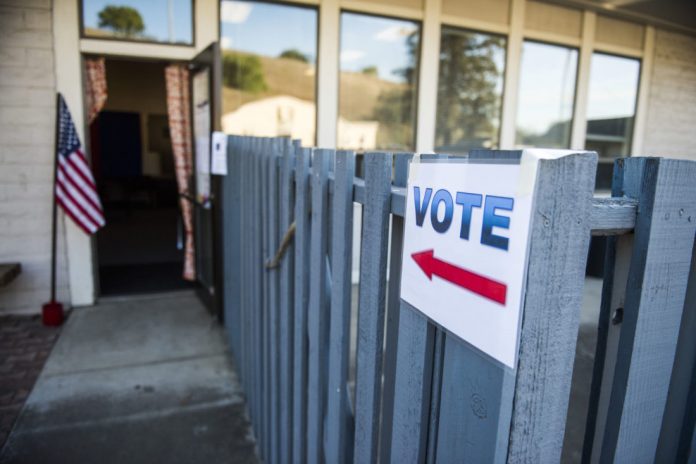San Benito County voters may be asked again this fall to vote on a countywide sales tax, a one-cent levy that would fund road repairs, maintenance and transportation projects.
Voters rejected a sales tax measure in 2016.
The Council of San Benito County Governments, the county’s regional transportation agency, is currently working on a ballot measure that would go before voters in November 2018. The sales tax would generate approximately $490 million over a 30-year period, according to agency staff.
“We are currently working on preparing an expenditure plan which would actually identify specifically what projects would be funded under the measure,” Transportation Planner Veronica Lezama said at last week’s intergovernmental committee meeting. “We are working closely with the cities and the county to develop that expenditure plan.”
The current county road network—673 miles of asphalt—needs various infrastructure improvements including regular road maintenance and a $180 million Highway 25 upgrade.
The average condition of county roads is considered a poor 38, according to the pavement condition index that rates roads on a scale from one to 100.
Upgrades and ongoing maintenance won’t come cheap. The county previously estimated it needed $398 million to maintain and repair all existing roads.
The transportation agency’s long-term Regional Transportation Plan anticipates a $1.8 billion need in regional road repairs, highways, and other transportation projects through the year 2040. Traditional federal, state, and other local funding sources are only anticipated to cover $1.1 billion of the need.
This fiscal year, San Benito County received over $650,000 from Senate Bill 1, which passed in the California legislature in 2017 and increased state gas taxes and vehicle license fees in order to raise funds for the state highway system and local roads. It is projected that SB1 revenues will increase over the years and the county could receive up to $2.68 million by fiscal year 2020/2021.
Despite that, concern over a possible attempt to repeal SB1 has prompted more interest in establishing a local sales tax to pay for regional road needs.
“Over the next month, [the agency] will be conducting a public poll followed by finalizing the expenditure plan and ballot question in May, ordinance approval by local jurisdictions in June, followed by the elections day deadline in August, and then of course the election in November of this year,” Lezama said.
This is not the first time county voters have seen a 30-year regional transportation sales tax. In 2016, voters rejected Measure P, which would have funded road repairs via a local sales tax.
San Benito County voters rejected Measure P in June 2016, when it fell short of the needed 66.67 percent by nearly 7 percentage points: 40.23 percent said No and 59.77 percent said Yes.
Neighboring regions like Santa Cruz County, Monterey County, and Santa Clara County were successful in passing their own 30-year sales tax increases that year.
The funding breakdown of Measure P had about 50 percent of funds going to Highway 25, 30 percent to local road repair, and the remaining 20 percent maintenance of the road network, Lezama said.
It is unclear what the breakdown of funding under the new proposed sales tax would be. Agency Executive Director Mary Gilbert said the breakdown for the new sales tax will be revealed in the future expenditure plan.
During the intergovernmental agency meeting, Hollister Councilman Karson Klauer said he was concerned about the amount of time to get the word out about a local transportation sales tax.
“It’s about building trust and communication with the community,” County Supervisor and agency Chairman Jaime De La Cruz said. The transportation agency plans to hold more public meetings over the next three months regarding the potential sales tax and expenditure plan.
“For Measure P, we did do an extensive outreach,” Lezama said. “The majority of the public expressed interest with having a variety of infrastructure projects. They provided support for Highway 25, as well as bicycles and pedestrians. That’s our goal, to try and see what the community is saying and incorporate that into the new sales tax. We are definitely taking a lot of lessons learned from Measure P and incorporating it in this sales tax so hopefully it’ll be a successful one.”
Resource Management Agency Director John Guertin expressed the importance of communicating with the community about the potential sales tax.
“It is their roads and money,” Guertin said. “They need to understand what they are approving and see that work actually get done.”
The next regular transportation agency board meeting is on Feb. 15 at 3pm at 481 Fourth St. in Hollister.
Agendas and other information on the Council of Governments is available online at www.sanbenitocog.org and on www.facebook.com/sanbenitocog.











Mr. Chief Justice John Marshall correctly concluded: “The power to tax is the power to destroy.” McCulloch v. Maryland, 17 U.S. 327 (1819). The Founders went to war over taxes that hardly appear on radar screens today. The confiscatory level of taxes/fees/fines/assessments/mandates, combined with crucifying regulations, have made California the Small Business Killing Fields. Every bankruptcy or business leaving is another pelt on local politicians’ wampum belts. They have made it so bad that the small business failure rate is 80% (4 out of 5) in the first five years. It’s worse for some (truckers, restaurants) than for others (doctors, realtors), but nobody is immune from financial distress. The wealth redistribution syndrome endemic in local government targets the self-sufficient, like transit agencies feasting off gas&diesel taxes, and our elected leaders aid and abet and condone the persecution. And they persecute us thru unelected joint power authorities like COG, where the appointed Directors of that governmental body, separate from the County and the two Cities, are immune from voters’ recall, and the Directors have no accountability to voters because they are appointed. Their waste is rewarded by our leaders, and concealed by false financial accounting that is prohibited for us to use by the State and federal tax regs. The conceal their immense waste of tax dollars by Enron-style, Bernie Madoff-style, “off book,” accounting, which a COG Chairman told me was “generally accepted government accounting.” Yep. Unaccountable, non-transparent, and have contempt for the voters. They just want to reward their special interest supporters, using O.P.M. (other peoples’ money—yours and mine). How many more neighbors from SBC will flee California? How many more small business owners will be forced into Bankruptcy Court. Our leaders refuse to cut their boondoggles, and instead, increase our tax&fee burdens, just like Sacramento does. They remind me of medieval physicians whose blood-sucking leeches killed their patients, and then blamed the family for not calling them out sooner to apply the blood-sucking leeches. And we let them do this to us? Unless we reverse course, we’ll be like Vallejo, Stockton, Detroit and the other bankrupt governments governing ghost towns whose residents fled. Caveat viator. Joseph P. Thompson, Esq., Past-Chair, Legislation Committee, Transportation Lawyers Assn. (408) 848-5506 e-Mail: Tr******@*****ll.Net